AutoPage Category project diary Page 6 of 7
This page is automagically created and paginated for each category available in the posts on this site
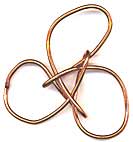
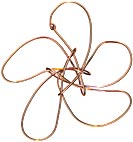 Since I can pretty much tie flower knots in my sleep, plus their interlacement points are minimal (compared to, say, the bao knot or the mystic knot) they were a no brainer for a quick experiment in wire. Obviously, I started with the 3 petal flower first shown in Wire Basics done with a pre-tied cord knot as a template. Why, you might wonder, would such a simple knot need a template? Couldn’t you freehand it? The answer is: maybe. The problem is that wire is very springy and requires at least 2 hands to bend in a controlled way. It’s just much easier to do with a template. Perhaps with experience and repetition you may no longer need a template, but to start… The ends were just slighly overlapped and left. They seem happy to stay that way.
Since I can pretty much tie flower knots in my sleep, plus their interlacement points are minimal (compared to, say, the bao knot or the mystic knot) they were a no brainer for a quick experiment in wire. Obviously, I started with the 3 petal flower first shown in Wire Basics done with a pre-tied cord knot as a template. Why, you might wonder, would such a simple knot need a template? Couldn’t you freehand it? The answer is: maybe. The problem is that wire is very springy and requires at least 2 hands to bend in a controlled way. It’s just much easier to do with a template. Perhaps with experience and repetition you may no longer need a template, but to start… The ends were just slighly overlapped and left. They seem happy to stay that way.
Read more
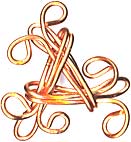
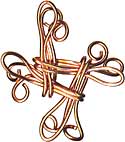 Documenting this backwards: the first knot I tried because of the simplicity of the structure and easy construction was the good luck knot. Significant amounts of twisted wire cluttered my work area until I decided to try tied knot templates. Simple folded shapes, each one the same, fit together to form the knot. A little fiddling with the ends to make sure the pieces don't pop back out completes the knots.
Documenting this backwards: the first knot I tried because of the simplicity of the structure and easy construction was the good luck knot. Significant amounts of twisted wire cluttered my work area until I decided to try tied knot templates. Simple folded shapes, each one the same, fit together to form the knot. A little fiddling with the ends to make sure the pieces don't pop back out completes the knots.
Read more
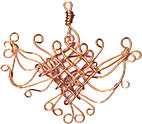
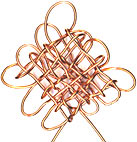 I have these visions of graceful scrolls and curls, but things never seem to turn out that way. What I should be doing, of course, is cut the wire much longer and not be so concerned about waste (does anyone recycle/re-smelt copper bits like they do silver?) then this piece won't be too short and that one too long and the whole design not gel.
Read more
I have these visions of graceful scrolls and curls, but things never seem to turn out that way. What I should be doing, of course, is cut the wire much longer and not be so concerned about waste (does anyone recycle/re-smelt copper bits like they do silver?) then this piece won't be too short and that one too long and the whole design not gel.
Read more
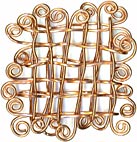
 While I still was without my needle tool, I considered ways to pull the wire through the already formed part of the knot with minimal di
Read more
While I still was without my needle tool, I considered ways to pull the wire through the already formed part of the knot with minimal di
Read more

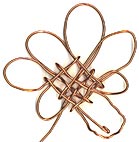 Tying knots in wire is a lot like tying knots in cord in higher gauges. That is to say when the wire is thin, it handles somewhat like cord.
Read more
Tying knots in wire is a lot like tying knots in cord in higher gauges. That is to say when the wire is thin, it handles somewhat like cord.
Read more

 Since I can pretty much tie flower knots in my sleep, plus their interlacement points are minimal (compared to, say, the bao knot or the mystic knot) they were a no brainer for a quick experiment in wire. Obviously, I started with the 3 petal flower first shown in Wire Basics done with a pre-tied cord knot as a template. Why, you might wonder, would such a simple knot need a template? Couldn’t you freehand it? The answer is: maybe. The problem is that wire is very springy and requires at least 2 hands to bend in a controlled way. It’s just much easier to do with a template. Perhaps with experience and repetition you may no longer need a template, but to start… The ends were just slighly overlapped and left. They seem happy to stay that way.
Since I can pretty much tie flower knots in my sleep, plus their interlacement points are minimal (compared to, say, the bao knot or the mystic knot) they were a no brainer for a quick experiment in wire. Obviously, I started with the 3 petal flower first shown in Wire Basics done with a pre-tied cord knot as a template. Why, you might wonder, would such a simple knot need a template? Couldn’t you freehand it? The answer is: maybe. The problem is that wire is very springy and requires at least 2 hands to bend in a controlled way. It’s just much easier to do with a template. Perhaps with experience and repetition you may no longer need a template, but to start… The ends were just slighly overlapped and left. They seem happy to stay that way.
 Documenting this backwards: the first knot I tried because of the simplicity of the structure and easy construction was the good luck knot. Significant amounts of twisted wire cluttered my work area until I decided to try tied knot templates. Simple folded shapes, each one the same, fit together to form the knot. A little fiddling with the ends to make sure the pieces don't pop back out completes the knots.
Documenting this backwards: the first knot I tried because of the simplicity of the structure and easy construction was the good luck knot. Significant amounts of twisted wire cluttered my work area until I decided to try tied knot templates. Simple folded shapes, each one the same, fit together to form the knot. A little fiddling with the ends to make sure the pieces don't pop back out completes the knots.
 I have these visions of graceful scrolls and curls, but things never seem to turn out that way. What I should be doing, of course, is cut the wire much longer and not be so concerned about waste (does anyone recycle/re-smelt copper bits like they do silver?) then this piece won't be too short and that one too long and the whole design not gel.
I have these visions of graceful scrolls and curls, but things never seem to turn out that way. What I should be doing, of course, is cut the wire much longer and not be so concerned about waste (does anyone recycle/re-smelt copper bits like they do silver?) then this piece won't be too short and that one too long and the whole design not gel.

 While I still was without my needle tool, I considered ways to pull the wire through the already formed part of the knot with minimal di
While I still was without my needle tool, I considered ways to pull the wire through the already formed part of the knot with minimal di Tying knots in wire is a lot like tying knots in cord in higher gauges. That is to say when the wire is thin, it handles somewhat like cord.
Tying knots in wire is a lot like tying knots in cord in higher gauges. That is to say when the wire is thin, it handles somewhat like cord.